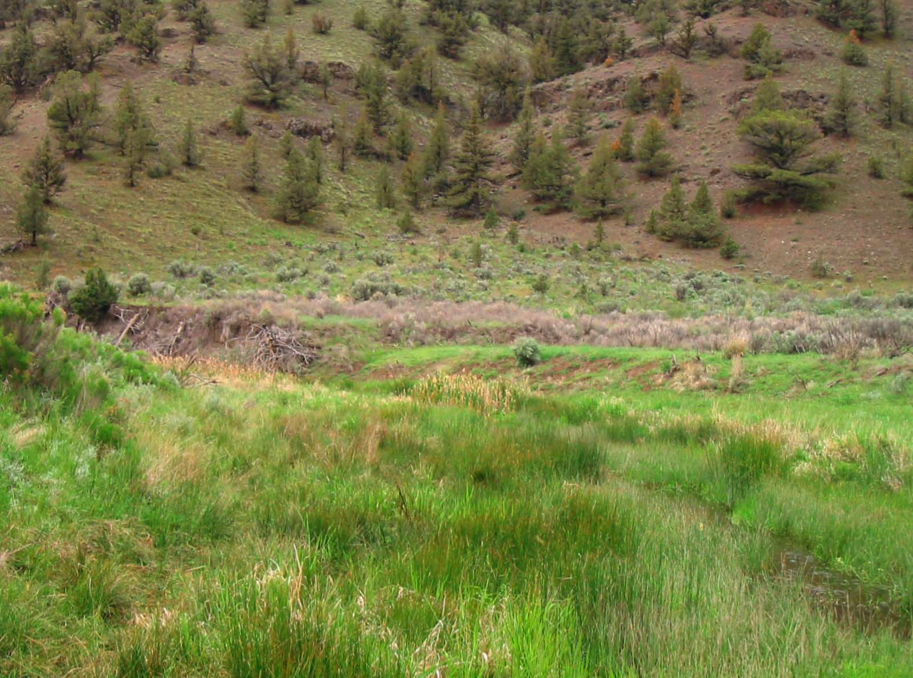
Keyline Agroforestry, Viet Nam
I am seeking actual examples of properties where regenerative agricultural practices have restored damaged land and increased their property values. Specifically, projects that used permaculture, holistic management / planned grazing, organics/biodynamics, soil foodweb / biofertile soils, and other regenerative agricultural practices. I want to find examples to support the growth and acceptance of these tools as potential means to create resilient, just, and sustainable human communities on the planet. To see some examples, keep reading below the fold.
For example, check out these photos from Bear Creek, shown by Kirk Gadzia during the Holistic Management session of the 2009 Carbon Farming Course:

Bear Creek, 1987

Bear Creek, 2003
Clearly, the living capital of this landscape has increased dramatically. And judging by the reports that have been written (here and here) using Bear Creek as an example, a large amount of intellectual capital and experiential capital was developed as well. I am also interested in the changing values of financial capital:
Do increases in living capital / ecological health (biodiversity, soil carbon, ecosystem services) actually lead to increased values in terms of financial capital?
In other words, is land worth more money after restoration than before?
I completely understand (see here and here) that financial capital is only one piece of the puzzle. AND, I want to be able to speak the language of the current capital system in order to help permaculture and holistic management and organics/biodynamics and other forms of regenerative agriculture spread and deepen in the current world.
Can you help build a portfolio of solid examples and well-articulated stories to draw from? Add your examples to the comments!
(Minimum info)
- Project/Property Name & Size
- Regenerative Agriculture techniques used
- Link/Reference for more info
(Other info I’d love to gather)
- Type of damaged/degraded land restored
- Timeframe of the project
- Photos (before & after)
- Initial property value (US$)
- Regenerated property value (US$)
- Other indicators of regeneration e.g. biodiversity, soil, etc. (before and after)


Pingback: What sort of soils are the Spodisols | Crop production
Good topic. And yes, agriculture can help restore damaged land.
I’ve taken over a landbase in Alberta, Canada that had been subject to overgrazing by non-conventional livestock (elk). Following the removal of the elk, the then land-owner decided to till the soil, not planting it, at the height of a regional drought.
Suffice to say, we’ve been dealing with barely any topsoil, vegetation limited to less than 10 species and no surface water. We’ve been at it 3 years and since the beginning our efforts in earthworks, re-afforestation, cover-cropping, food forestry, and selective disturbance patterns have allowed us to not only begin increasing the natural capital of the site but also use it as an intellectual resource for demonstrating regenerative land-use design and implementation.
Property values (including the addition of net-zero housing and out-buildings) have gone up alot but considering we will never market the land-base as realty, the real profit is ecological and psycho-social.
Keep up the good work.
If you can catch him for a minute, I’d expect Abe Collins could provide you his experience and farm as an example. From a technical perspective, it would be hard to parse out the financial gains made strictly due to improved land/ecosystem. In articles he’s written of his work, he describes gains in dairy production per head of cattle, which he attributes to revisions in his grazing patterns; these changes also increase topsoil formation. But how much of the (presumable) increase in financial value of his operation is due to the topsoil formation itself as opposed to the changes in nutrition for the cows resulting from changed grazing? The dollar-economics of the situation are pretty tangled up even though it’s easy to simultaneously conclude that improving the land does contribute to financial value. HOW much they contribute is the tricky part.
Greening the desert with Geoff Lawton…
http://www.youtube.com/watch?v=sohI6vnWZmk
Not mine, obviously. But it is an extreme example of the land gaining in value.